In early 2017, brothers Justin, Travis and Griffin McElroy had just wrapped up a live-taping of their hit podcast, “My Brother, My Brother, and Me,” in Portland, Oregon. In between selling out theaters on their nationwide tours, the trio was perpetually busy building a family entertainment business that now spans books, television and more than a dozen podcasts. But back at their hotel that night—possibly thanks to some legal edibles gifted by a fan—they hatched a scheme that was zany even by their standards. Could they persuade DreamWorks to cast them in the forthcoming Trolls sequel?
“As entertainers, we thought it was funny—this idea that we would get into this children's movie by hook or by crook,” says Justin. The more difficult task would be persuading DreamWorks that the brothers’ desire was more than an elaborate joke.
What unfolded over the months that followed involved a brand new podcast—aspirationally titled “The McElroy Brothers Will Be in Trolls World Tour”—documenting their journey, a bungled meeting with Dreamworks executives, and a social media fan campaign that one Trolls World Tour cast member described as “confusing.” Nonetheless, in September 2018, Justin found himself driving from his home in Huntington, West Virginia, to a recording studio in Cincinnati, Ohio. As unbelievable as it seemed, he would read lines for six different parts in Trolls World Tour. Set for on-demand release on April 10, the follow-up to 2016’s Trolls finds main characters Poppy (Anna Kendrick) and Branch (Justin Timberlake) in a race to save trolls’ diverse musical cultures from a band of rock-and-roll trolls determined to silence them.
What essential magic does the Trolls franchise possess, that it could motivate three grown men to spend years lobbying DreamWorks for bit voice acting roles? And how did the toy itself not only endure for more than 60 years, but catch Hollywood’s interest anew?
The Origin of the Troll Doll
The story of troll dolls began in the small town of Gjøl, Denmark, during the economic precarity that followed World War II. According to board game designer Tim Walsh’s 2005 book Timeless Toys, Thomas Dam (1915-1989) was a baker whose livelihood vanished when the local flour factory shuttered. Struggling to support his young family, Dam shoveled snow for cash while formulating a new plan for earning a living. Early in the morning, or at night when he returned, Dam would sit near the fireplace, carving bits of wood while he thought. He often carved funny creatures to entertain his children, and eventually, his wife persuaded him to try selling the figurines. Dam packed up as many as he could carry and traveled to Aalborg, the nearest city, where he planned to knock on doors. He came home empty-handed, having successfully sold them all.
As Dam’s figurines found fans in Aalborg, customers began commissioning bigger projects. Before long, Dam became a working sculptor whose reputation eventually exceeded Denmark’s borders. In 1956, a Swedish department store hired him to create a large sculpture of Santa Claus, kicking off the chain of events that nudged Dam to fully embrace toy making.
When he finished installing the Santa Claus sculpture, Dam realized that it wasn’t completely visible from the street. He proposed an accompanying window display with a clever design. First, he sculpted tiny figures of Christmas elves—designed in a similar style to his soon-to-be-famous troll dolls—and dismantled a mattress, hiding a spring in each figurine’s body. Next, Dam built a display with a mechanism that lifted and dropped a long piece of wood. When the dolls were fixed to the wood, its gently undulating motion caused their springs to bounce. “[These trolls] were standing there waving, jumping up and down and their heads were rolling,” recalled Niels Dam, Thomas Dam’s son, in Timeless Toys.
The window display worked, and the store was flooded with requests from customers eager to purchase dolls of their own. Dam raced to fulfill the orders, selling out his entire stock by Christmas. But the original dolls were expensive to produce, requiring painstakingly handmade details and expensive springs.
When demand showed no sign of slowing, Dam began tweaking the design to scale production. He had already switched from hand-carved wood to rubber molded in reusable gypsum casts. Under a newly minted company dubbed Dam Things, he replaced the dolls’ springy bodies with more affordable rubber ones stuffed with wood shavings. By 1959, Dam established a small factory in Gjøl, and in 1961, he switched to an even more efficient production process called rotational molding, using the same PVC plastic that troll dolls are made of today.
The Rise and Fall
By 1962, Dam’s trolls had become an international sensation, fueled by a new network of factories spanning New Zealand to Florida. With prices ranging from roughly 65 cents up to $5.95 per doll, trolls were a vehicle for pricier add-ons, such as clothing and accessories. A 1966 Sears advertisement tempted shoppers with exclusive releases, including a troll village playset and a “prehistoric model home furnished in true Troll decor.” Dam’s original Good Luck Trolls—renamed Wishniks when sold by a U.S. distributor—encouraged children to rub their trolls’ colorful hair for good fortune.
Trolls continued their rise to fame. When President John F. Kennedy welcomed Betty Miller, the first woman to pilot a solo trans-Pacific flight, to the White House on July 19, 1963, he also greeted her troll doll, Dammit, who served as a good luck charm onboard her famous flight. First lady Lady Bird Johnson was also fond of trolls, and reportedly had a doll of her own. According to Walsh, Americans purchased more than one million Dam trolls in 1964 alone. The record sales even drove Dam Things to purchase Iceland’s entire harvest of sheepskin for use as the dolls’ iconic hair.
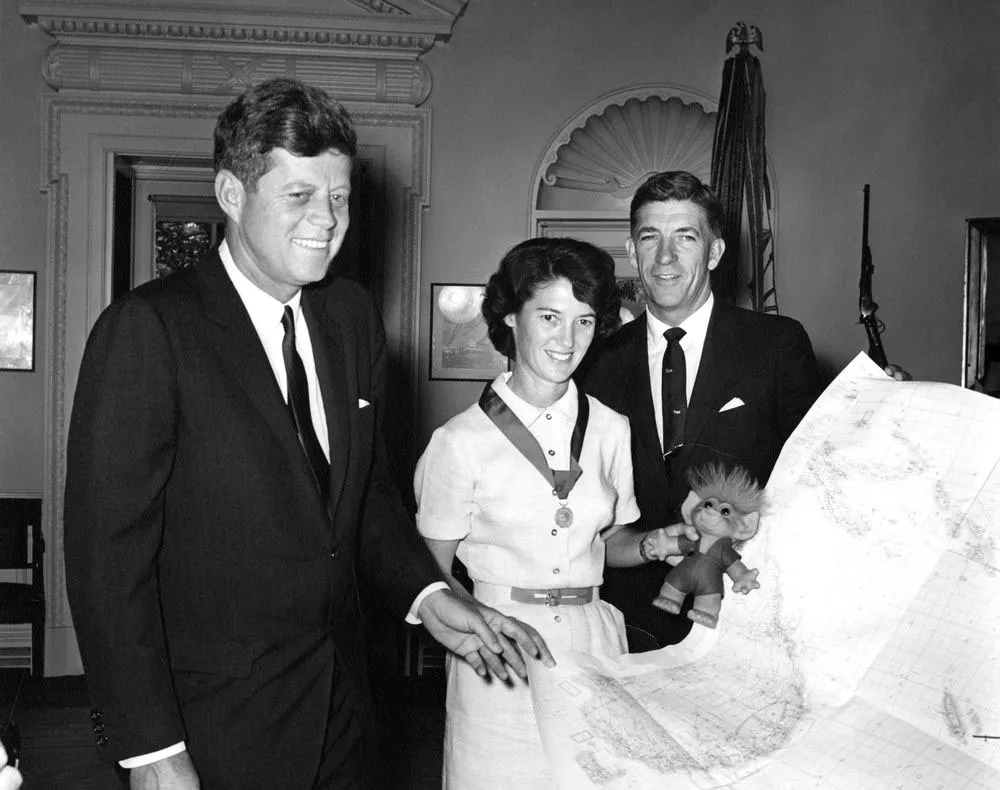
Walsh believes troll dolls arrived in the U.S. at a fortunate moment. He compares trolls to the Spirograph, a toy that generates symmetrical designs which found traction thanks to the 1960s’ obsession with colorful mandalas. The troll dolls’ mile-high Day-Glo hair channeled a hippie aesthetic, while their wrinkled faces and exaggerated features echoed the surreal, psychedelic artwork that appeared on record sleeves such as King Crimson’s The Court of the Crimson King, which was released in 1969. “I think they were the perfect doll at the perfect time,” Walsh says.
Yet trolls’ appeal might run even deeper, back to the mingled anxiety and wonder that originally inspired myths about the creatures. “We kind of dismiss a comment like ‘they’re so ugly, they’re cute,’” Walsh says. “But you can also say ‘they’re so scary, they’re cute.’” In Scandinavian mythology, trolls dwelled on the edges of society, in menacing forests, castles and underneath bridges. They harassed and kidnapped women, demanded tolls, and sometimes possessed magical powers. Walsh points out that troll dolls’ electrified hair and wide eyes could be interpreted as the expressions of terror. For children, troll dolls may have exuded an alluring mix of harmlessness and horror. Dam’s designs embraced this duality, exaggerating the trolls’ features until they became adorable. “They were so ugly that you couldn’t help but laugh,” Dam said, “and when you laugh, luck follows you."
Americans collectively spent more than $100,000 on trolls per month in the toy’s heyday. Although only one company, Uneeda, was licensed to sell official Dam trolls, competitors including Lucky Schnooks, Fauni Trolls and a host of unbranded mimics exploited a gap in U.S. copyright law, pumping out similar toys with cheaper materials. Although Dam obtained a U.S. copyright for his trolls in 1965, Uneeda had already sold countless troll dolls by then, miring them in the public domain. Children may have been indifferent to the branding, but for the Dam company, the competition stung.
The Comeback
By the 1970s, enthusiasm for the wrinkled creatures faded. But in the words of Walsh, “toys are unusual in their ability to stick around.” This is, in part, because some toys invite nostalgia that translates into generational waves of sales. When troll doll enthusiasts grew up and started families, they naturally wanted to introduce their children to the toy. Right on schedule—two decades after their heyday, at the 1983 New York Toy Fair—a couple named Steven and Eva Stark debuted the Norfin line of trolls. The dolls were officially licensed Dam trolls and came with a new range of facial expressions designed to encourage collecting. "Trolls are like potato chips," Eva Stark told Newsweek in 1992. "Nobody is satisfied with just one."
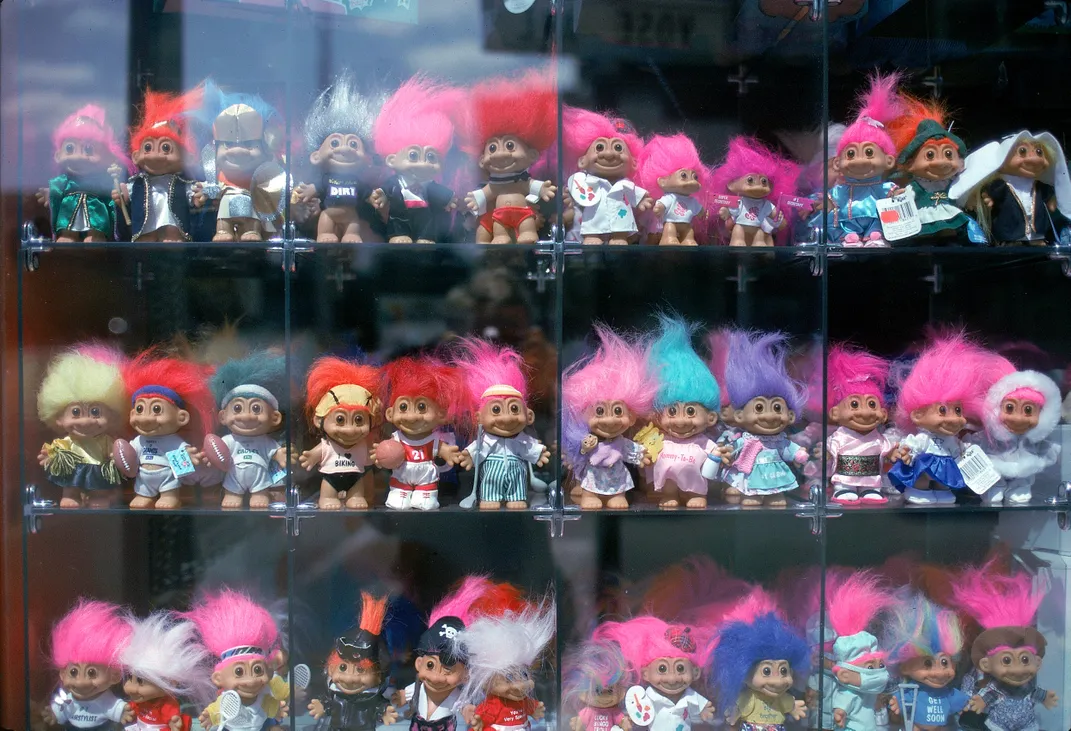
Ella Andreasen learned this lesson in 2016, when she decided to part ways with a couple Halloween-themed trolls her mother had purchased from Target in the 1990s. A marketer by day, Andreasen moonlights as EllaTheSella, the name of the vintage Etsy shop she runs part-time from her home in Minnesota. That’s where she posted her childhood trolls—only to be surprised by the response. “They got so much traffic and so many favorites,” she says. “There was really a big buzz about them.” Andreasen had stumbled across a thriving subculture of troll collectors. Intrigued, she began joining Facebook groups where collectors swap tips and share knowledge about troll dolls and memorabilia.
Nostalgia often shapes the perceived value of different trolls or types of trolls. With copyright issues still unresolved, unlicensed varieties continued to emerge during the late 1980s through trolls’ second peak during the early 1990s. Among them, Ace’s Treasure Trolls added an iconic rhinestone belly button marketed as a lucky “Wishstone” (borrowing heavily from Dam’s original Good Luck Trolls playbook). Hasbro took a different tack with its line of Battle Trolls, which had bulging muscles and brandished theatrical weapons like a band of miniature pro-wrestlers. “Everyone likes the stuff that they grew up with,” Andreasen says.
One of the most popular non-Dam troll varieties came from Russ Berrie—the same type Andreasen’s mother used as decorations, and which Adreassen sells on Etsy today, scouring thrift stores, flea markets and Facebook Marketplace. Named for its founder, Russ Berrie, the Dam competitor climbed to prominence by selling trolls—as much as $150 million worth in 1992, up from $200,000 in 1988. Trolls were such an important component of the company’s success that Berrie’s own wedding featured bride-and-groom troll cake toppers and 160 pink- and blue-haired trolls gifted to guests. Still, Dam trolls, as well as officially licensed trolls such as Norfin, tend to claim the highest prices among collectors.
Nonetheless, serious troll collectors often specialize in Dam and non-Dam varieties alike. In New York City, an artist named Reverend Jen Miller famously turned her apartment’s living room into the Lower East Side Troll Museum, sharing her collection of 400 trolls with visitors by appointment. (Miller put her trolls in storage when she was evicted in 2016 and has since brought them out for pop-up exhibits, including New York’s Outsider Art Fair in 2019.) In 2013, collector Ray Dyson, based in Edmonton, Canada, secured the Guiness World Record for his collection of more than 4,000 trolls—only to be usurped in 2018 by collector Sherry Groom, a retired psychiatric nurse who has an astonishing 8,130 troll dolls and remains the world record holder today. Troll fans can visit Groom’s collection in Alliance, Ohio, where she and her husband run the Troll Hole, a two-story museum that displays an additional 22,000 pieces of troll-related memorabilia.
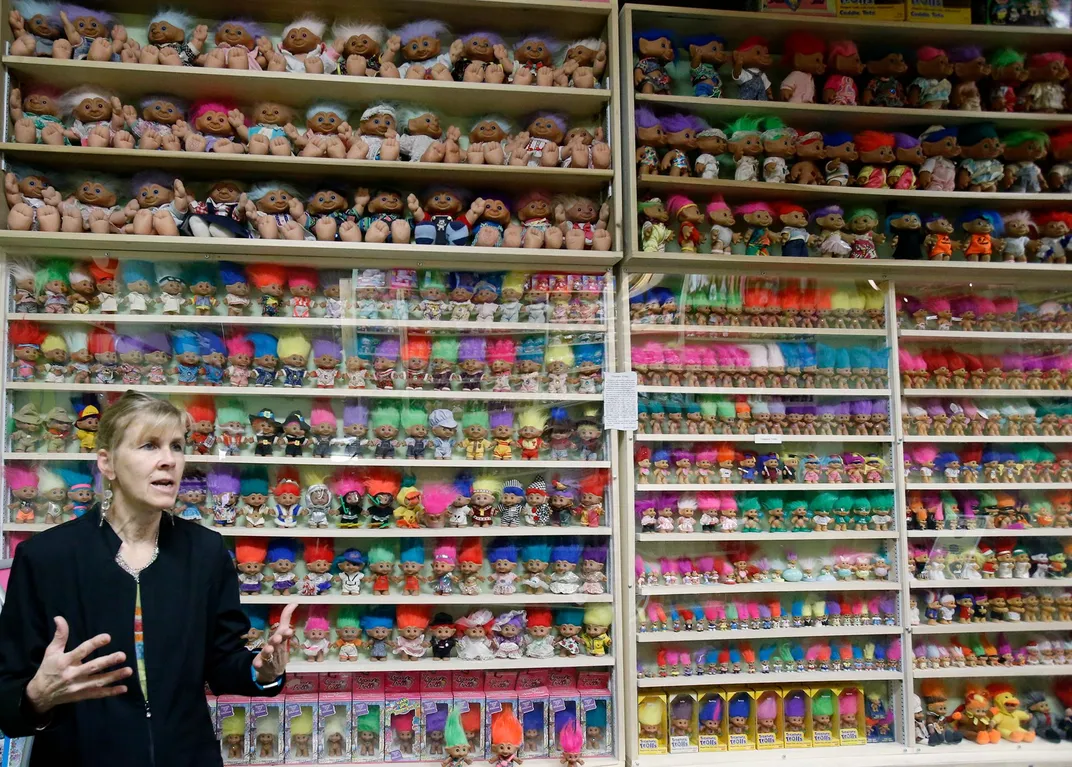
Groom began collecting as a child during the 1960s, when family members and friends gifted her trolls. Then, as troll dolls’ popularity ebbed after the 1990s boom, she found opportunities to purchase secondhand collections of 300 to 500 troll dolls at a time. “I always try to convince people on the tour that I'm not a creepy troll collector,” Groom says, laughing. “I just happened to have some, and then we monetized it, and then it really took on a life of its own.”
Ultimately, the 1994 Uruguay Round Amendment Act spelled the end of the saturated troll market. The legislation amended U.S. copyright law to bring it into alignment with a treaty called the Berne Convention. As a result, foreign companies and individuals whose intellectual property had previously been part of the public domain received copyright privileges once again. At last, in 1996, Dam Things managed to restore its troll doll copyright.
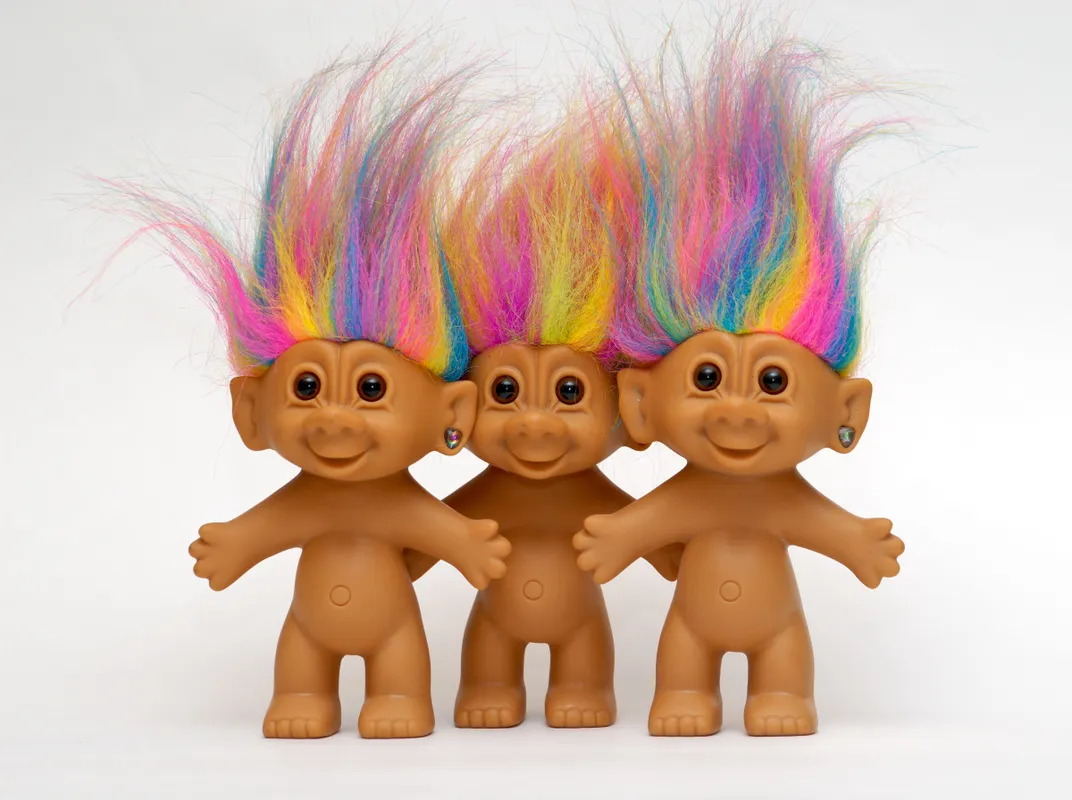
Although Russ Berrie trolls had been sold since the initial American troll boom in 1963, the company agreed to stop selling trolls in 2004, following a lengthy copyright infringement lawsuit brought by Dam Things. (The debacle didn’t halt Russ Berrie; today, the company is still known for its gift shop goods and plush stuffed animals, as well as its philanthropic foundation.) In subsequent years, retailers ranging from Urban Outfitters to Uneeda itself faced lawsuits from Dam Things for selling unlicensed troll products.
The Next Generation of Troll Fans
In 2013, DreamWorks ushered in a third phase of enthusiasm for trolls by acquiring the official licensing rights from Dam Things. Its adaptation—which starred Anna Kendrick and Justin Timberlake as technicolor trolls with a musical flair—introduced trolls to a new generation of children, whose parents may have played with Russ Berrie trolls or Norfin trolls in the 1990s. When DreamWorks’ Trolls screened at Cannes, the mix of original and classic songs left two Vanity Fair critics entranced and emotional. (“[W]e cried. O.K.? We cried at Trolls.”) The movie went on to earn an Oscar nomination for Best Achievement in Music Written for Motion Pictures (Original Song) for “Can’t Stop the Feeling” performed by Justin Timberlake, plus nearly 40 additional awards and nominations.
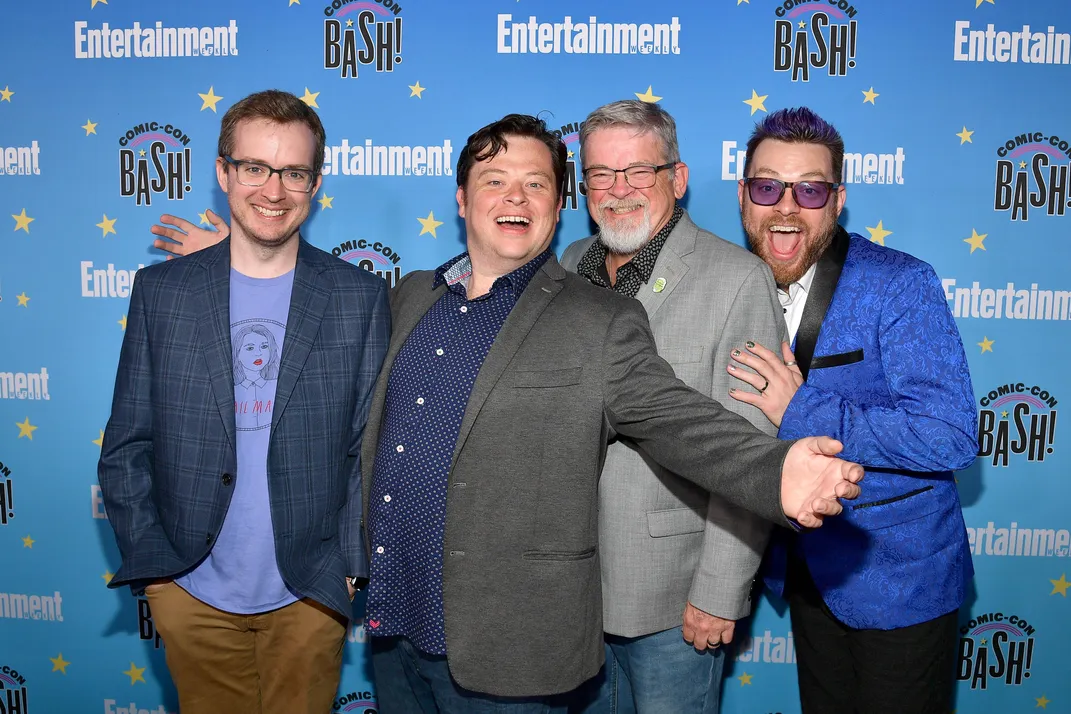
In an unexpected twist, its sequel, Trolls World Tour, is now being hailed as "a case study for Hollywood’s digital future.” As the world reels from the coronavirus pandemic, DreamWorks announced that Trolls World Tour’s release date would move up a week, to April 10—in stark contrast to other movies, which are being delayed until theater screenings become possible again. Priced at $20 for digital streaming access, Trolls World Tour’s distribution may become more common as studios and streaming services alike find new ways to deliver movies directly to viewers.
The McElroy brothers didn’t expect Trolls World Tour to provide a model for future Hollywood releases—but then, they didn’t expect to be cast at all. The brothers’ motivation wasn’t rooted in personal nostalgia; according to Justin, they didn’t have troll dolls as children, other than the odd neon-haired pencil-topper. But all three have young children who are right in the pocket of the Trolls franchise’s intended audience. “As dads, we thought it would be impressive to our children,” Justin says.
In particular, Justin’s daughter, Charlie, is a dedicated Trolls fan who inherited her aunt’s vintage troll doll collection and even has a handmade trolls-style wig for playing dress-up.
Though the McElroys achieved the unlikely feat of being cast in Trolls World Tour, the movie may hold further surprises. Given that each brother recorded all six of the voice acting parts DreamWorks offered, it’s still possible that they’ll be surprised by the casting, or unable to tell who voiced which character thanks to autotuning. While Justin was officially cast as an anthropomorphic tumbleweed, he admits he has doubts after watching the trailer. “I would swear on a stack of Bibles it's Griffin,” he says. “I won’t tell him that—I’ll continue to insist it’s me—but I know my own brother’s voice so well.”
Regardless, one thing isn’t a mystery: Trolls have earned their status as an iconic toy. If the 30-year cycle holds steady, the world is due for another troll resurgence.
For DreamWorks, it seems, trolls have brought good luck.
/https://tf-cmsv2-smithsonianmag-media.s3.amazonaws.com/filer/28/53/28539af5-d535-4d87-b4fa-09970acfeba2/trolls-mobile.jpg)
/https://tf-cmsv2-smithsonianmag-media.s3.amazonaws.com/filer/99/e6/99e6ce7b-a25f-4995-bc63-593788927bdb/trolls_header.jpg)
/https://tf-cmsv2-smithsonianmag-media.s3.amazonaws.com/accounts/headshot/michelle.png)


/https://tf-cmsv2-smithsonianmag-media.s3.amazonaws.com/accounts/headshot/michelle.png)